

Intro
Most of our reviews are pretty long — and take a long time to produce — because we want to provide enough info for you to actually determine whether the gear we tested will work well for you.
But we get asked to check out an increasingly wide range of products, and sometimes, we just want to tell you about something we’ve been using and loving lately.
So that’s where this monthly series — Stuff We Like — comes in, where we keep you current on a broad range of stuff we’re currently digging.
And if there’s something you love that you think we ought to check out, drop us a note in the comment section below.
The North Face Women’s Summit Series Pumori Down Jacket
MSRP: $650
Kristin Sinnott: The Pumori Down Jacket is part of The North Face’s Summit Series, which they describe as their “pinnacle performance collection.” Having just watched Trango (a new film featuring TNF athletes Jim Morrison & Christina Lustenberger debuting at Sundance this winter) and seeing how the jacket was put to the test by both athletes, I am not surprised that it has become my go-to this winter.
Temperatures in the Gunnison Valley can be extremely cold, especially in December and January; this year has been no exception. There have been multiple weeks where I’ve headed to the gym in below-zero temperatures, with my car thermostat often showing -18 ℉ / -27℃. I don’t have a garage, so I often find myself sitting in the car waiting for it to warm up or scraping the windshield in these temperatures; the 800-fill-power, water-resistant “Prodown” of the Pumori Down Jacket has kept me warm each morning.
I have also worn this jacket for evening ice skating sessions in frigid temperatures, spectating during my son’s hockey practice at the outdoor rink, and many outdoor events over the holidays.




I definitely haven’t tested the full range of capabilities I know the jacket is designed for, like the dual zipper for belaying, climbing-helmet-compatible hood, and more, but when I’ve needed a jacket to keep me warm, the Pumori has been my go-to. The warmth-to-weight ratio is very impressive and while the coat looks big, it compresses into its stuff sack easily.
I have the Pumori in size Medium and while the fit is generous, I think it’s perfect for layering on top of other jackets and sweaters. On the coldest days – which tend to coincide with my son’s hockey practice — I even wore the Pumori over Ortovox’s new downwool jacket (more on that jacket later) and I was extremely toasty and comfortable. At 5’8”, 135 lbs (173 cm, 61 kg), the Medium is a great fit.
There are plenty of better options if low weight and packability aren’t high priorities, but if they are, the Pumori is an extremely warm and packable insulator.
Patagonia W’s Iron Forge™ Fleece-Lined Bib Overalls
MSRP: $169
Kristin Sinnott: I’m not generally an overalls person, but lately, I’ve added a number of them to my wardrobe. That includes Patagonia’s Iron Forge Fleece-Lined Bib Overalls, and I’ve found them to be ideal for cold winter days. I love wearing them to school pick-up (the school is always shaded and cold during pickup in December and January), ice skating, shoveling, and anything that involves standing outside in the cold. The 100% recycled polyester microfleece lining is warm but not too bulky.
I wear them in a size Small, and for my 5’8”, 135 lbs (173 cm, 61 kg) frame, I think I could have sized up to a Medium just as easily.
Luke Koppa: I’ve also been using some of Patagonia’s fleece-lined pants, and they’ve definitely come in handy this winter. I have the men’s Iron Forge Fleece-Lined 5-Pocket Pants, which are basically the non-overall men’s version of the bibs Kristin has. Overall, I’m a big fan of how warm they are, and I appreciate how supple yet rugged the outer canvas fabric is. They’re pretty straightforward — warm, fleece-lined pants with a burly canvas face fabric made of industrial hemp, recycled polyester, and organic cotton. I.e., Patagonia’s take on a cold-weather work pant.


My only minor gripe is with the fit, and that’s obviously a personal thing. But, for a work-oriented pant, I would prefer a bit more room through the thigh and/or some articulation at the knees. I think this becomes even more notable with lined pants, since there’s just more material to bulk up at the knees, thigh, and butt area. I don’t have massive quads, but I regularly wish these pants were a bit more generous in that area (despite having plenty of room in the waist). I typically wear a size 32 waist in pants and opted for the same in these; they have a pretty standard “straight” fit but I would prefer if they hung a bit looser overall for better range of motion.
Flylow Youth Baker Jr Bib & Youth Explorer Jacket
MSRP: $200 (bib) & $200 (jacket)
Kristin (& Linden): Flylow debuted their kids line for the 24/25 season, and their Youth Baker Jr Bib and Youth Explorer Jacket have been our go-to for snowsports this season. Made from the same fabrics as the adult versions, the mini-me kits bring the steeze to 4-year-olds and up.
My son was 5 when he started wearing the kit and is still wearing the size 4 jacket and size 4 bibs. A year later he’s still wearing the same kit. The jacket fits great, with the torso and sleeves an ideal length for my fairly petite son. The bibs run extremely long but they are still comfortable to wear, and they still look good despite the excessive length. We roll the cuffs up 2 in / 5 cm and twist the bib straps a few times to shorten the straps so they don’t keep falling down. The straps have a buckle to shorten the length, but even at the shortest length, they are still much too long for my son’s torso. But between the strap twist and the velcro cinch waist, the pants are comfortable on him.






This is my son’s second season wearing this kit and the light insulation in the jacket and bibs has proven to be extremely helpful for keeping him on the slopes even in the coldest weather. On warm days, we ditch the midlayers and utilize the pit zips and leg vents if he starts to get sweaty. The helmet-compatible hood is also a win and something we haven’t seen too often from other kids’ apparel brands.
After logging 60+ days in the kit, it still looks relatively new, likely thanks to the extra tough fabric on the knees. If you’re looking for a new kit that will keep your child warm and dry on the mountain, take a look at Flylow’s new line.
Skida Snap Vest
MSRP: $98
Kara Williard: Skida recently released their first vest as part of their Fleece Collection, and within a couple of times wearing it, it quickly became my favorite piece of apparel I’ve had in quite a long time. It’s equal parts practical and fashionable, and I’ve found it such a subtle but fun upgrade to so many outfits. It also provides an appreciable amount of added warmth, which has been a huge benefit during an extremely cold December and January here in the Gunnison Valley.
I’ve been a fan of Skida’s fleece for a while now, having worn their High Pile Hat the last couple of winters. This material is really soft and warm, but not stifling and still breathes fairly well. As far as the vest itself, this is a pretty simple piece, but I think Skida nailed it in terms of its design and fit. It’s such an easy piece to throw on over any outfit.
I’ve been wearing the size M/L, which is comfortable and roomy but not oversized (for reference, I’m 5’9”, 170 lbs / 175 cm, 77 kg). It’s a relatively short cut, which I think works well since I am usually layering it with longer shirts and dresses, or higher-ride jeans. While I’ve been using this as more of an everyday lifestyle piece, it’s also viable as an extra layer while skiing.
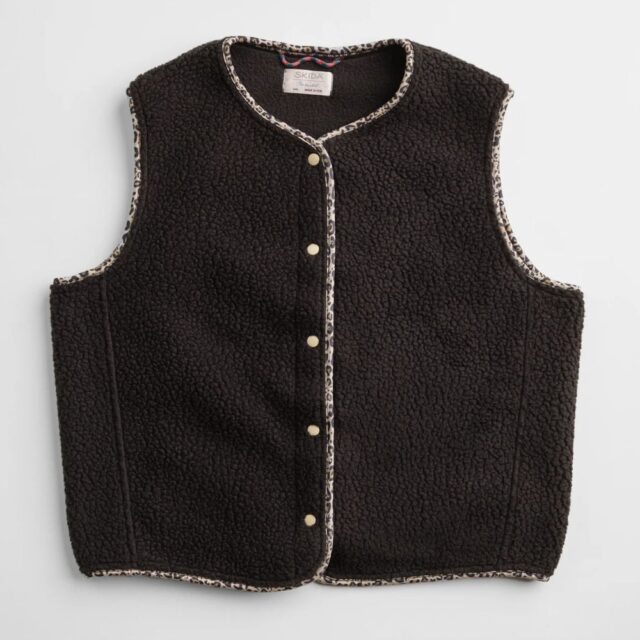
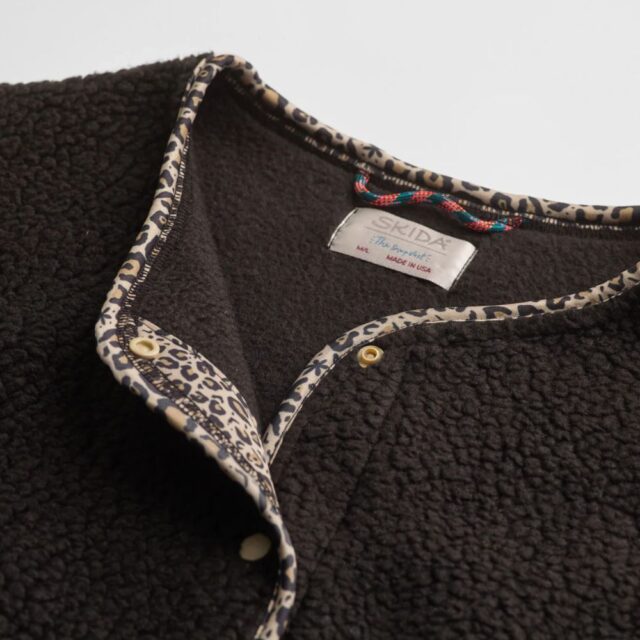
As with all Skida products, the Snap Vest is handmade in the U.S., and the care and attention to detail are evident. The snaps are easy to clasp and durable, and the subtle details of the pattern around the edges make it fun and provide a little extra flare to any outfit. If you see me out and about this winter, I will probably be wearing the Skida Snap Vest.
Passage Hat Co. Monashee & Tantalus Hats
MSRP: $45 (Monashee) | $40 (Tantalus)
Luke Koppa: Passage is a new brand that was launched with a very specific focus: making better hats for outdoor activities. Their current lineup consists of two five-panel models — the fleece-lined Monashee and the non-insulated Tantalus — and both are designed and manufactured in Canada.
A few of us at Blister have now been using them for nearly a year, and I’m a pretty big fan overall. I’ve spent most of my time with the Monashee, and despite initially fearing that it’d be too warm for my quick-to-sweat head, it’s become a staple for me during ski-touring season.
The Monashee uses a stretchy softshell fabric that’s treated with a DWR finish and lined with a low-pile, midweight fleece. That’s paired with a very flexible recycled brim (including a dark under-bill to reduce glare) and an adjustable elastic strap with a quick-release clip closure.
I always skin in some sort of hat, mostly to keep my hair and the sun out of my eyes, and the Monashee has been an ideal option for my winter and spring ski tours. Despite the fleece lining, my head doesn’t seem to get much sweatier in the Monashee than any other hat I’ve used in the winter, and the Monashee provides a nice bit of added warmth when the temperatures are frigid. That’s more noticeable when I throw a helmet over it, and this combo is made comfortable by the Monashee’s lack of a top button (in contrast to most six-panel hats).
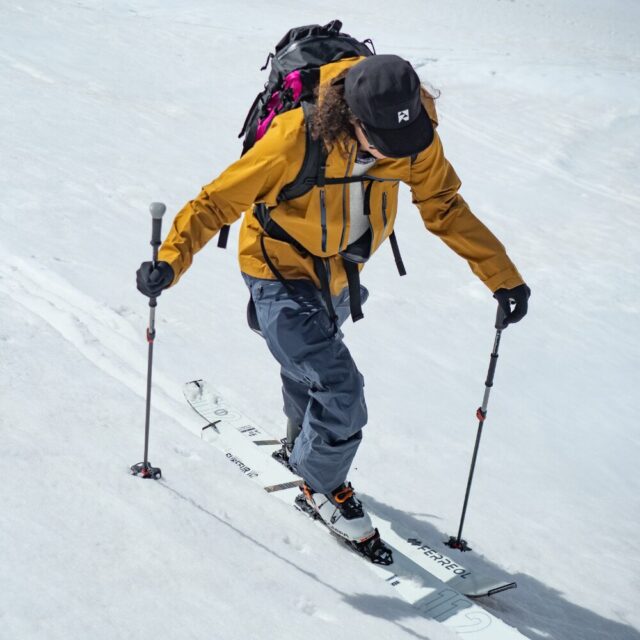
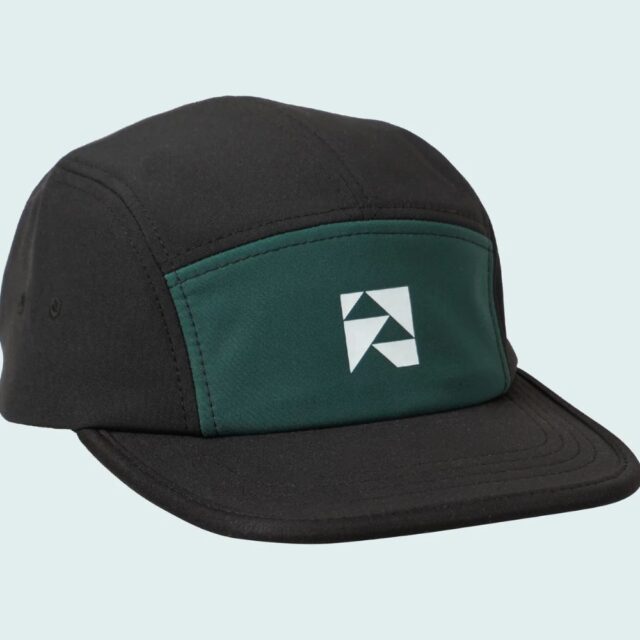
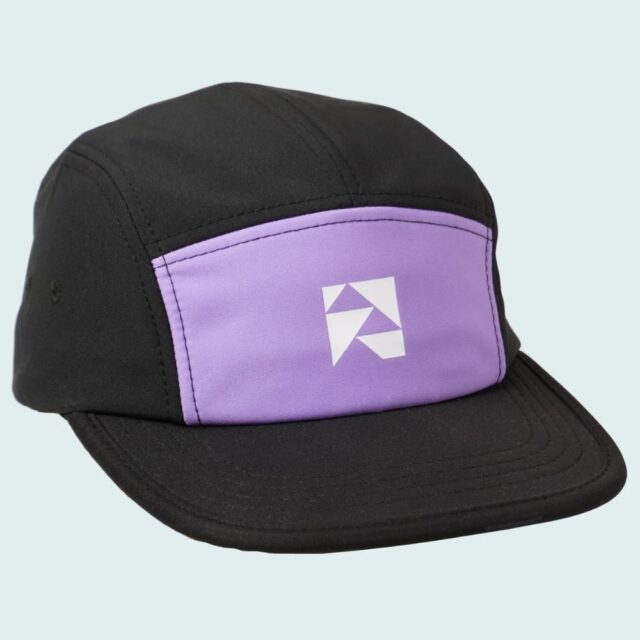
Because of its stretchy fabric and super pliable brim, I can stuff the Monashee into any crevice of my pack; upon removal, it regains its shape just fine. Despite its lined fabric, the Monashee dries very quickly and its exterior fabric is better than average when it comes to resisting absorbing moisture from precipitation.
As for the fit, the first-gen hats that we’ve been testing seem like they’ll work for most people — between the stretchy fabric itself and the adjustable elastic back strap, they’re pretty adaptable. For me and my big dumb dome (24” / 60 cm circumference), they’re just a bit short / ride a bit high on the back of my head. However, Passage says that their current hats feature a slightly tweaked fit designed to let your head sit slightly deeper in the hat and allow the brim to lay a bit flatter. That was really my only complaint with the hats, and it’s totally specific to my head, so I look forward to testing the next generation.
For now, the Monashee is a great five-panel for those who want a hat that’s weather resistant, quick to dry, highly packable, and offers a bit of warmth for high-output winter activities.
Kara Williard: Like Luke, I have really enjoyed my on the skin track in a Passage hat this season, but it hasn’t stopped there – because I’ve enjoyed some of the features of this hat so much, I’ve also found myself wearing it at the gym, out for aprés, and more.
I’ve been testing the Tantalus, which is a similar five-panel design as the Monashee, just without the fleece lining. What has been most enjoyable about this hat is that it’s a very comfortable fit on my kinda-weird-shaped head, and it doesn’t leave any marks on my forehead from digging into my skin, like most baseball / brim hats do. This makes it extra comfortable, plus its breathability and wicking properties have made for a hat that actually makes sense when it comes to activities where I am sweating a lot or working hard.
The DWR-finish has helped keep my head drier during some stormier days in the backcountry. I also often layer it under a beanie, which keeps snow out of my eyes while still having a warm and functional hat on my head that isn’t trapping as much moisture or sweat as an average brim hat would.
The Tantalus’s material is soft and stretchy, and I find the hat as a whole a bit more flexible and comfortable than my other favorite brim hat: the Skida Brim Hat. This flexibility not only improves the comfort, but means I can smash it down into my pack or pocket without fear of permanently bending the brim or anything like that. I plan on using the Passage Tantulus Hat as my main hat for most of the other trips I have planned this winter.
Finisterre Wool Sweaters & Knitwear
MSRP: $160+
Kara Williard: I typically wouldn’t consider myself someone who enjoys wool sweaters or knitwear, but I’ve recently realized this was just because I hadn’t found the right knitwear that was soft, comfortable, and warm. Thankfully, this has all changed now that I’ve had the chance to wear / live in some sweaters from Finisterre this winter.
For those who aren’t familiar with it, Finisterre is a UK-based brand that was founded by British surfers back in 2003. They built a brand of durable and practical outdoor clothing for the often cold and wet weather they dealt with. Looking at their lineup, it stands out from a lot of the mountain-based outdoor apparel brands, probably because Finisterre was built as a brand originating from a cold, coastal climate, and I have been nothing short of impressed by a couple of pieces I’ve tried so far.
I’ve spent the majority of the last few weeks in some of their women’s wool sweaters: the Women’s Cavan Ribbed Knit Sweater and the Eyre Roll Neck Knit Sweater. Both have been instrumental in getting me through temperatures as low as -29°F / -34°C here in the Gunnison Valley. They are impressively warm, but also breathable and not stifling once you enter a warm indoor space, allowing me to stay comfortable in all extremes.



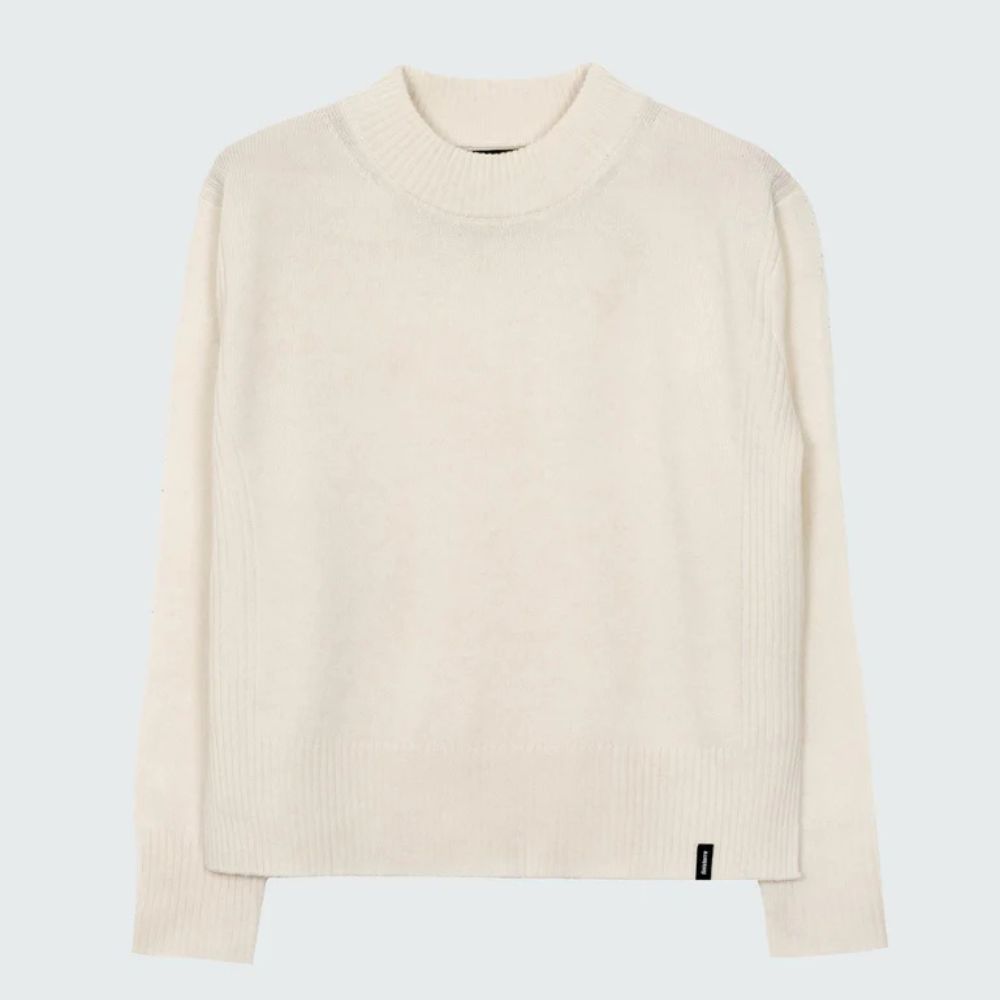


The Eyre Roll Neck Knit Sweater is a heavier and bulkier sweater than the Cavan Ribbed Knit Sweater, and with the added benefit of the turtleneck, I just can’t help but put on the Eyre for any of the freezing cold days when I feel scared to go outside. It’s so warm and does an excellent job of insulating. It’s dense enough that I can’t feel the cold air seeping through, but it’s also a very good wicking and breathable fabric, and I have yet to find myself sweating or overheating in it.
I chose a US women’s size Large after looking at their UK to US size chart, and the size Large was perfectly roomy and loose. This has been ideal for layering while still looking fitted enough to feel cute.
What stands out the most is the feel of the wool. It is quite soft against my skin and I don’t feel nearly as sensitive to it as I have in many other wool sweaters from other brands. The Cavan Ribbed sweater is a thinner knit and not quite as warm, but with its more delicate pattern and lighter fabric, it feels a bit dressier and is a great piece to wear out to dinner, around town, etc.
It’s also worth noting that Finisterre is a certified B-Corp and publishes public data about its carbon footprint, impact, and where its wool is sourced from. They also run the Finisterre Foundation, whose mission “aims to remove barriers to access so everyone can get to and benefit from the transformative power of the ocean.”
There is a lot of information on Finisterre’s website about their history and values, and all of that makes the sweaters that I’ve loved all the more rewarding to wear.
I’d recommend checking out their entire men’s and women’s lineup. Aside from a ton of really nice wool pieces, they also offer lifestyle clothing, jackets, baselayers, socks, and more!
P.S., I already ordered two more sweaters because it’s officially the only thing I want to wear this winter (it’s -16°F at my house as I am writing this, and you better believe I am wearing the Eyre Roll Neck Knit Sweater).
Esker ArchSupport Insoles
MSRP: $50 USD
Zack Henderson: I’ve got pretty high arches and tend to prefer using aftermarket insoles in pretty much all of my sports-related footwear. While I typically go with more common options from SuperFeet or Sidas, I stumbled across the made-in-Canada, plastic-free insoles from Esker and decided to give them a go — and I’m very glad I did.
Esker’s approach uses a natural rubber and linen canvas structure to create a natural-materials-based insole blended with the mythical warmth, wicking, and stink resistance provided by merino wool. I’ve been running them in a couple of pairs of riding shoes and have found that they keep my feet toasty in cold winter conditions while also drying quickly. The shape offers ample support for my feet and a deep heel cup, though folks who don’t need as much support can opt for their cheaper ($36 USD) and lighter LowProfile design.

The one inconvenience with the Esker insoles was the initial fitting. They are quite wide — much wider than any stock insoles I’ve seen — and despite Esker’s claims that they don’t require trimming, I wasn’t able to stuff them into any of my more “performance-oriented” footwear. That said, they were easy enough to trim down a bit, and I’ve since managed to fit a pair into my wife’s new ski boots. I haven’t yet had a chance to test them in warm conditions, where I do worry that they may start feeling a little too warm, but they’ve been impressively comfortable and supportive for my ventures into grim winter weather.
Party Shirt International Women’s Stretch Tech
MSRP: $55
Kara Williard: I’ve long said I don’t have enough fun clothes and costumes to live in the Gunnison Valley, since this is a community that will use just about any excuse to “dress up” (and by that, I’m definitely not talking about black tie outfits…). I’ve slowly been working on growing my costume collection as a result, which has been super fun, but an extra asset in the part-outfit lineup is something that is both technical and fun. After all, most of the dressing-up outings here involve outdoor activities. Party Shirt International’s Stretch Tech shirt is a perfect example of this, and it’s been such a fun and practical piece to have — one I’ve found myself wearing on birthday bike rides, ski tours, and just for fun activities in between.
The Stretch Tech tee is exactly what it sounds like: stretchy and technical. It’s a great wicking material and is made of highly breathable fabric. Party Shirt International has so many fun colors and patterns that it’s hard not to justify wearing a fun (and practical) shirt for a wide array of activities and outings. I find this to be a great option for anyone who is active but wants a little flare for some of their outings. The women’s size Large I got is a roomy and loose fit, making it quite comfortable. I’d definitely keep Party Shirt International in mind for someone looking for a fun layer that is still perfectly apt for sweating and working out.


Muck Artic Sport Mid Boot
MSRP: $165 USD
Simon Stewart: My search for a slip-on winter boot had been going on since Luke wrote about the Fubuki Niseko 2.0 Boots in our Holiday Gift Guide back in December of ‘23. My search criteria were essentially the same as Luke’s; warm, waterproof, and convenient.
So the question is, why didn’t I just get the same boots since Luke has been raving about them ever since? The answer is fairly simple — I have big feet. Luke, on the other hand, has normal-sized feet, yet the Fubuki boots still look giant, and I couldn’t imagine how huge they would be in a size 13… I imagined myself not being able to fit them in the footwell of my car, not to mention I’m already self-conscious of my foot size, so I really don’t need anything drawing more attention to them.
[Editor’s Note from Luke: just imagining a pair of size 13 Fubuki’s does make me giggle.]
My search eventually led me to the Original Muck Boot Company, and given that I come from across the pond where ‘wellies’ are a mainstream footwear staple, I was drawn to their utilitarian welly style. The warmest boots offered by the Muck are the Artic Sports, and they come in tall and mid heights. I opted for the mid-height version.

The Artic Sport boots feature an MS-1 molded outsole that is fully lined with 5mm-thick CR Flex-Foam neoprene, plus fleece for additional warmth. There is 2mm-thick thermal foam under the footbed to further isolate your feet from the cold ground. The Artic Sport boots are, as to be expected, 100% waterproof. Muck claims a comfort range of -40ºF to 40ºF / -40ºC to 4ºC for the Artic Sport boots, so on paper, they check the ‘warm’ box.
So far, the Artic Sport boots have been great. One of the reasons I wanted a slip-on boot is for the convenience of quickly stepping into them to pop outside to grab firewood, shovel snow, clear off the car, etc. Additionally, I wanted something where I could easily slide my feet out and into ski boots in ski area parking lots — the Artic Sport boots have been amazing at all those things.
They are surprisingly comfortable and decently supportive (for a slip-on, welly-like boot, that is). I do have some heel slip when walking, but that is entirely expected. And to be clear, I didn’t get them to be hiking boots, nor do I plan on wearing them hunting — I have fancy insulated lace-up boots for that. With that said, I think I may grab some of the Esker ArchSupport Insoles Zack talks about above (in the cold-weather version) to add a bit more support.
We’ve been having a bit of a nasty cold spell here in Colorado, and my feet have been mostly staying warm in the Artic Sport boots. Now, the caveat is I haven’t spent extended periods outside in them (again, which is not why I bought them). And from my experience so far, I’d say the -40ºF / -40ºC comfort range might be a bit optimistic since I started feeling a bit cold when it was -7ºF / -21ºC. They were still warm enough at that temperature to be comfortable, but I could feel the cold start to creep in, at least enough to temper my expectations for even colder temperatures.
In hindsight, I kind of wish I had gone with the tall-height version now that I’ve seen people wearing them with the tops rolled down — that would give the option of having the tall height for deep snow days while also being just like my mid-height boots the rest of the time.
The only disappointing thing was that I couldn’t find them for sale in any stores in Colorado or New Mexico that are listed as dealers. I really wanted to walk into a store, try them on, hand over some money, and walk out with new boots. That didn’t happen, and I probably went into at least seven different stores before I gave up and ordered them online. You would think the Artic Sport boots would be the exact ones to stock in the winter for Colorado and New Mexico, but sadly, that was not the case.
Overall, I’m super happy with the Muck Artic Sport Mid boots, and I’ve pretty much lived in them since it got cold. Consider all the boxes checked since they are exactly what I was looking for.
ProTaper A25 Aluminum Handlebars
MSRP: $105 USD (currently on sale for $53)
Zack Henderson: Most people have come around to the benefits of more compliant handlebars as a means of reducing fatigue, while consequently recognizing some of the shortcomings of the 35 mm bar bore standard in adding undue stiffness. I typically prefer a 31.8 mm bar bore, but I’ve been really enjoying the 35 mm variety of the ProTaper A25 Aluminum bars.
Shape-wise, their 4° upsweep and 8° backsweep work well for me, and the A25’s 25 mm of rise is a nice middle ground for the bikes I’m currently riding. ProTaper offers five different rise options, starting as low as 12 mm and going all the way to a whopping 76 mm — about the same as the eye-popping custom bars that Dakotah Norton has been running. While the chrome sticker decals on my anodized black set of bars feel a bit cheap and will likely peel at some point, the brushed finish and anodizing on the aluminum itself looks quite classy.
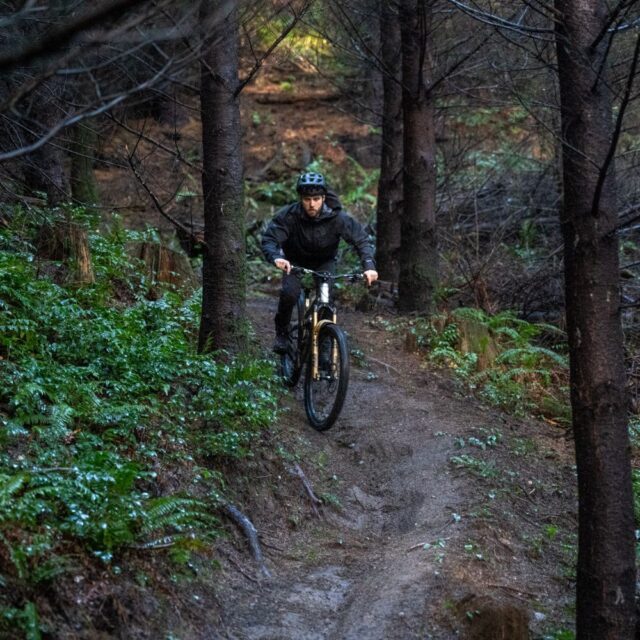
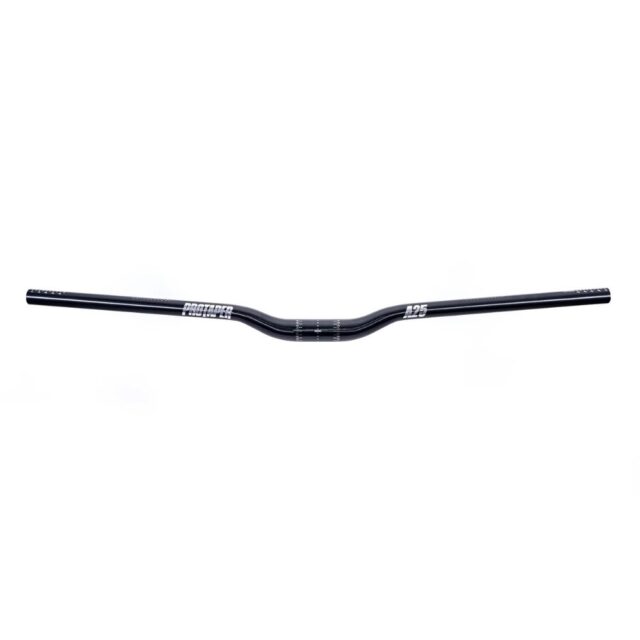
The ProTaper A25’s standout feature, though, is how well they mute vibrations for a 35 mm bore bar. They don’t feel quite as comfy as some 31.8 mm bars, but they are quite good in the world of 35 mm bars. I have also really liked OneUp’s aluminum bars and found them comparably forgiving, if not slightly more so, but I’ve found limitations in their size range — 20 mm rise is often too low, and 35 mm is too tall for my needs. The ProTaper A25’s 25 mm of rise is just right for my needs, and given their performance, I’m planning to keep them around for a while.
David Golay: I’ll just jump in to add that the 31.8 mm version of the A25 (or the higher-rise A38, depending on my rise needs for the bike in question) is my current go-to bar, for basically the same reasons that Zack laid out. I haven’t tried the 35 mm diameter version to see how it compares to the 31.8 mm one in feel, but the 31.8 mm version stands out for being especially smooth-riding and comfortable.
I’d personally prefer a touch less backsweep — I tend to like relatively little — but the 8° / 4° shape is fine, and the combo of ride feel and ample rise options is great. They’re definitely not the stiffest bars out there by a long shot, but I haven’t minded — and to bring Dakotah Norton back in, I’ve heard him quoted as saying something to the effect of “I’ve never once been in the middle of a race run and wished my bars were stiffer.” I’m right there with him.
Zack’s right that the decal durability leaves a lot to be desired, but the finish of the bars themselves is quite nice, and they look great if you just peel the decals off all the way once they start to degrade. Either way, I’m a lot more worried about how the bars feel than how they look when I’m actually out riding, and the A25s are a real standout there.
They’re also 50% off directly from Protaper at the time of writing this.
Coros Apex 2 Pro
MSRP: $449
Dylan Wood: I was a fan of my Series-6 Apple Watch for a while, but then its lack of battery life and other quirks began to annoy me. I then found the Coros Apex 2 Pro, and I’ve been really happy with this high-end GPS outdoor smartwatch.
With 66 hours of stated GPS battery life, my watch battery anxiety has disappeared. This means that the Apex 2 Pro can supposedly last 66 hours straight during GPS tracking; for everyday use without using the GPS, the Apex 2 Pro can reportedly last up to 30 days without needing a charge.
This means that, during a typical week where I use my watch to record 2-4 hours of activity a day, my Apex 2 Pro usually only needs to be charged every 10-14 days. And when I do need to charge it, it only takes about 2 hours to go from fully drained to 100% charged.


I’m not just a fan of the Apex 2 Pro’s battery life. It has several helpful features you’d come to expect from a smartwatch, including sleep and stress tracking, counting my daily steps and active calories, and other helpful features like a nap timer, oximeter, map, and more. The Apex 2 Pro comes with a comfortable nylon wristband, and most of the time, I forget it is on my wrist while it is measuring important vitals and recording long activities, both indoors and outdoors.
With 29 different activity modes and a custom mode for unsupported activities, the Apex 2 Pro can record just about every activity I do, whether I am skiing in the resort or backcountry, hitting the gym, sessioning the climbing wall, or riding my bike. The Apex 2 Pro reportedly works in temperatures ranging from -20 to 50º C (-4 to 122º F). It’s also water resistant, allowing me to record my whitewater kayaking activities and keep my watch on in the hot tub after a good workout.
So far, my only quarrel with the watch is that it doesn’t have any e-bike modes. It’s a bit silly, but I have the Apex 2 Pro set up to auto-sync with my Strava, and I would rather not cause alarm by taking KOMs every ride, then changing my activity to an e-bike ride later in Strava. That’s my only frustration with the watch so far, though, which is telling.
If you’re looking to upgrade your smartwatch and recording outdoor activities is a priority for you, I’d definitely recommend considering the Coros Apex 2 Pro.
Sophia Ray Mountain Goods Hats
MSRP: $42
Dylan Wood: Whenever I need something new, I’ve been trying to buy locally rather than from large, anonymous corporations. So, when it was time for a new hat, I was happy to get a comfortable, 5-panel style hat from Sophia Ray Mountain Goods. Based right here in Crested Butte, artist and photographer Sophia Ray produces art with many different mediums, from prints to apparel and the top sheets of skis from Romp, a local ski manufacturer.
I really appreciate that Sophia’s hats are ethically sourced in Canada and Nepal and made out of 100% recycled materials. The hat is comfortable and durable, with supple fabric designed to hold up to repeated outdoor use. Her hats also feature her unique art, with prints that are sublimated into the hat’s fabric, resisting wear and tear. I opted for her “Rainbow Trout” design, which stands out without being too “loud” — my typical preference for hat designs.
If you’re in the market for a new hat that will likely spend more time on your head than off of it, I’d recommend checking out Sophia Ray’s small business.


Kitworks Gear Storage
MSRP: Varies
David Golay: Kitworks is a relatively new company offering a range of modular gear storage and transport options. I’ve been trying a few of their different offerings and like them quite a bit.
In short, there are two main base-storage designs — a Gear Tote (in 35 and 55-liter sizes) and a collapsible hard-sided 75-liter Gear Box. (There’s also a duffel bag coming soon.) From there, both the tote and box feature a ton of mounting points for a whole bunch of different styles of dividers, pockets, internal gear cubes, and other organizers so that you can set them up to suit your needs and preferences.
The modularity is great, but the most standout thing about the tote and box is just how burly they are. Both are primarily constructed from recycled 900D ripstop material that’s treated with a TPU laminate to make them waterproof, even more durable than the base fabric on its own, and easy to clean. Both also collapse down relatively small, but the tote has a good bit of structure to it and the box has fully rigid sides (Kitworks says the box can support 200lb). In the case of the tote, that makes it quite a bit easier to load and keep organized than a more conventional soft-sided tote bag. The Gear Tote also has two separate handles — one for hand carrying and one for shouldering — and a pair of buckled straps that go over the top to help prevent stuff from falling out.




Between testing apparel, being prepared for a range of weather conditions, having shoes for a few different pedal systems, and so on, I keep quite a bit of riding gear in my truck. I’ve been using the Gear Box with the Divider Set and a few System Pockets, and this system has made it way, way easier to keep all that stuff organized and easily accessible. I’ve got separate spots for jerseys, pants, jackets, shoes, socks, and gloves (separated by intended use / weather conditions). The Gear Tote comes out when I’m taking a smaller assortment of gear — typically when carpooling with a friend to the trailhead. Both are great, and the whole system has been a big life upgrade for me.
Yardsale P1 Poles
MSRP: $149
Noah Eckhouse: Ski poles are a part of my ski kit that haven’t seen much innovation in my 50+ years of skiing. After all, my daily driver is still a pair of aluminum Scott poles with the molded plastic handgrips — aka, the ones I purchased in 1982 at the UMass ski sale when I was 15.
So, when I got the chance to try some new supposedly state-of-the-art ski poles, designed by a former Apple product design engineer, I thought it might be time for this dog to learn some new tricks.
My son and I have been testing these poles for nearly 30 ski days, and we have a number of good things to say about them. First of all, they show up in a box where you assemble the pole like a LEGO set (which was actually kind of fun). It didn’t take long, but it made me appreciate their attention to detail in the construction of the ski pole shaft, hand grip, strap, and basket. I opted for Ski Patrol Red with standard straps and the resort baskets.


After assembling, we explored all the terrain Crested Butte has to offer — bumps, groomers, powder, and steeps. The poles did their job well. The strap adjustment system is better done indoors when your hands are warm, but once set, it has performed well. Yardsale’s standout feature is the magnets buried within their grips and baskets, and they meant it was easier to carry these poles since they literally stick together. A novel, if not altogether critical, feature.
From my perspective, the single best thing about these poles is that they come with a lifetime bend / break guarantee. Yardsale says if you ever damage a pole shaft, “tell us the story and we will send you a replacement.” That’s pretty cool; sooner or later, ski poles always seem to get bent or broken.
My only issue was the resort baskets. They are small rectangles, protruding out from the pole shaft at a right angle. They are fastened to the bottom end of the pole with a hard plastic rectangle, which means this system is excellent at catching trees and shrubs when you’re skiing off piste. Most baskets have a convex shape to them, with more flexible plastic construction that seems to do a better job of bending and/or sliding off obstacles. The Yardsale baskets are rigid and effectively create a 3 inch hook. I haven’t had a chance to try the Yardsale’s optional powder baskets, but viewing them online indicates the hard plastic remains.
One option I didn’t get to try was the MagStrap System, which allows the strap to release from the grip in case of a bad fall, reducing the chances of your wrist getting hung up in the pole strap.
With a ton of customizable colors and options, you can configure these poles like a car. That’s pretty cool. I will be interested to see what Yardsale does next in their approach to innovating traditional ski products.
Helly Hansen Odin Everdown Hooded Jacket
MSRP $450 (currently available for $338)
Jed Doane: This down jacket from Helly Hansen features a unique patented down system from Italy called Thindown. From what I gather, it consists of down that is processed to a relatively consistent density and then adhered to two lightweight liners on either side. This means the jacket doesn’t require baffles. This is not an entirely new technology, but it’s the most recent adoption by a major outdoor brand in a compelling design package. In my experience, this has resulted in a jacket with a good warmth-to-weight ratio, fewer seams to rip, and a more durable face fabric than in other jackets.
I wore the Odin Everdown Jacket through the fall and early winter and found it to be a solid midweight down jacket. At about 350 grams, it’s very light but not the lightest jacket on the market, especially considering its lack of features like zippered hand pockets. What it loses in absolute lightweight focus it gains back in a more durable face fabric compared to others like the Rab Mythic G, and the Odin Everdown is also very warm for its weight. Its lack of seams also bodes well for long-term durability, and I imagine the inner liner fabric around the down would provide additional protection in the long term, though it’ll be hard to say until I’ve used it for several years.

Sitka Ambient 75 Hoodie
MSRP: $279
Luke Koppa: I often get random texts from our reviewer, Paul Forward, about some new gear he’s been testing or heard about. A few years ago, he sent me a message asking if I’d tested Primaloft’s new “Active Evolve” insulation. I told him I hadn’t, and he then relayed how impressed he’d been by some Sitka prototypes he was testing that utilized this “active insulation.”
This past fall, I was looking for a layer that would cover the gap between the chilly mornings / evenings and hot midday hours of Colorado archery hunts, and I remembered that text from Paul.
Now, I’ve used several active insulators that work very well for this use case — think high-output activity, with temps from roughly 25–55°F (-4 to 13°C). However, the jackets I have that I’d normally pick (e.g., Patagonia Nano-Air Light Hybrid, The North Face Summit FutureFleece) are in some very non-stealthy colors. As the temperatures slowly dropped throughout September, I decided to try the Sitka Ambient 75 Hoodie (after somehow finding a shop selling it for 50% off).
Since then, I’ve been really impressed — when it comes to combining warmth, breathability, weather resistance, and weight, this might be the best active insulator I’ve tried.


Primaloft makes several versions of their Active Evolve insulation, but all of them utilize some sort of low-density, high-loft fleece material. In contrast to traditional batted “puffy” insulations, Active Evolve doesn’t require a lining or even face fabric. In concept, it’s very similar to Polartec Alpha, Outdoor Research’s “VerticalX Octa” insulation, the “VR Warm” lining used in Rab’s Vapour-Rise Summit Jacket, and The North Face’s new FutureFleece collection that we’re testing this winter.
(FutureFleece has been very promising so far, but I still want to do a bit more testing before discussing it in an upcoming edition of Stuff We Like.)
Many of these low-loft-fleece insulations promise better breathability and/or warmth-to-weight ratios than more traditional, denser-knit fleece layers. And they’re supposed to provide improved breathability relative to more traditional batted puffy insulators (even “active” ones like Primaloft Gold Active).
However, the versions of these fleece insulations that don’t use a face fabric often lose nearly all their insulative value if worn as an outer layer in even slightly windy conditions. And, in the past, I typically found them a bit less warm than active insulators that used batted insulation sandwiched between face and lining fabrics.
Sitka’s Ambient 75 Hoodie has been bucking those trends. Under a shell, I think it offers as much warmth (or maybe more?) as Patagonia’s standard Nano-Air Jacket, which uses their 60-g FullRange batted insulation between face and lining fabrics. But the Ambient 75 breathes about as well as the Patagonia Nano-Air Light Hybrid Jacket, which uses a lighter 40-g insulation around the core and more breathable R1 Air knit elsewhere. And, unlike some of the lightest, lowest-density fleeces I’ve tried, the Ambient 75 still offers an appreciable amount of wind, precip, and abrasion / snag resistance.
The Ambient 75 Hoodie is the lightest / least-warm option in Sitka’s Ambient collection, and I’m glad I didn’t opt for the 100-g or 200-g variants. The Ambient 75 Hoodie is surprisingly warm, especially given that it only features the Primaloft Evolve insulation around the chest, upper back, and over the arms (elsewhere, it uses a more breathable Polartech grid fleece). My size Large also only weighs 273 grams and packs down to roughly the size of a grapefruit.
As an outer layer, I can typically comfortably wear the Ambient 75 Hoodie over a thin baselayer in temperatures from roughly 15–50°F (-9 to 10°C) during moderate-output activities (e.g., casual skinning pace, fairly fast hiking). But I can comfortably wear it as a midlayer under a shell in temperatures down to 0°F / -18°F during lower-output activities like lift-accessed skiing.
I run fairly hot, so those scenarios might not match your own comfort levels with this piece, but the main point is that I’ve found it surprisingly versatile — maybe the most versatile midlayer I’ve tried. Now, I’m not talking about drastic night-and-day differences when comparing similar pieces, but the Ambient 75 Hoodie’s combination of warmth, breathability, weight, and weather resistance has continually impressed me.
The Primaloft Evolve fleece lining does snag a bit on some grabbier fabrics like merino wool, but I haven’t found it any worse in this regard than other similar low-density-knit insulations. I also think the Ambient 75’s lack of an internal lining fabric is part of why it wicks moisture quite well and dries very quickly.
The Ambient 75’s lightweight 20D ripstop face fabric helps it slide under other layers, and it’s held up quite well to plenty of bushwhacking. I also appreciate that the Ambient 75 doesn’t accumulate odor buildup quite as quickly as most active insulators I’ve tried.
One key thing to point out is that, unless you’re very familiar with it, Sitka’s sizing can be baffling. A size Medium is typically ideal for me in the vast majority of midlayers and baselayers from other brands (I’m 5’8”, 155 lbs / 173 cm, 70 kg). Going with a size Large for Sitka’s baselayers and midlayers has been much better for me. The size Large Ambient 75 Hoodie is a bit longer than most of my size Medium midlayers from other brands, but it’s not much more voluminous / roomier. It’s a pretty slim fit, and I think many people will prefer a size larger than their usual.
Overall, the Ambient 75 Hoodie is a really interesting option in the active insulation category. Within my collection of insulators, it’s become one of my go-to outer layers for high-output activities on cool-to-cold days without significant precipitation, and one of my go-to midlayers for lower-output activities on cold-to-frigid days.
If I stopped testing apparel and had to use only one midlayer for a full year of outdoor activities in the mountains of Colorado, the Ambient 75 Hoodie is probably what I’d pick (though I’d likely opt for the more understated, non-camo colorway).
